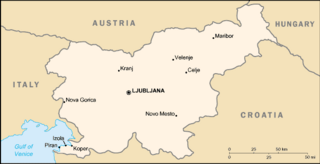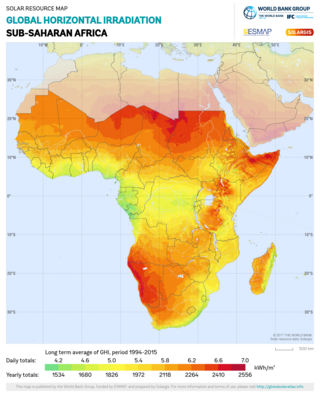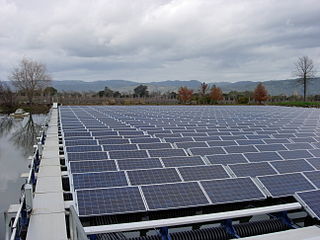
Photovoltaics (PV) is the conversion of light into electricity using semiconducting materials that exhibit the photovoltaic effect, a phenomenon studied in physics, photochemistry, and electrochemistry. The photovoltaic effect is commercially used for electricity generation and as photosensors.

Solar irradiance is the power per unit area received from the Sun in the form of electromagnetic radiation in the wavelength range of the measuring instrument. Solar irradiance is measured in watts per square metre (W/m2) in SI units.

Many countries and territories have installed significant solar power capacity into their electrical grids to supplement or provide an alternative to conventional energy sources. Solar power plants use one of two technologies:

Solar power in India is a fast developing industry. The country's solar installed capacity was 61.625 GWAC as of 31 October 2022. Solar power generation in India ranks fourth globally in 2021.
For solar power, South Asia has the ideal combination of both high solar insolation and a high density of potential customers.

Solar power is the conversion of energy from sunlight into electricity, either directly using photovoltaics (PV) or indirectly using concentrated solar power. Photovoltaic cells convert light into an electric current using the photovoltaic effect. Concentrated solar power systems use lenses or mirrors and solar tracking systems to focus a large area of sunlight to a hot spot, often to drive a steam turbine.

A photovoltaic system, also PV system or solar power system, is an electric power system designed to supply usable solar power by means of photovoltaics. It consists of an arrangement of several components, including solar panels to absorb and convert sunlight into electricity, a solar inverter to convert the output from direct to alternating current, as well as mounting, cabling, and other electrical accessories to set up a working system. It may also use a solar tracking system to improve the system's overall performance and include an integrated battery.

Historically, the main applications of solar energy technologies in Canada have been non-electric active solar system applications for space heating, water heating and drying crops and lumber. In 2001, there were more than 12,000 residential solar water heating systems and 300 commercial/ industrial solar hot water systems in use. These systems presently comprise a small fraction of Canada's energy use, but some government studies suggest they could make up as much as five percent of the country's energy needs by the year 2025.
Wind resource assessment is the process by which wind power developers estimate the future energy production of a wind farm. Accurate wind resource assessments are crucial to the successful development of wind farms.

Concentrator photovoltaics (CPV) is a photovoltaic technology that generates electricity from sunlight. Unlike conventional photovoltaic systems, it uses lenses or curved mirrors to focus sunlight onto small, highly efficient, multi-junction (MJ) solar cells. In addition, CPV systems often use solar trackers and sometimes a cooling system to further increase their efficiency.

A rooftop solar power system, or rooftop PV system, is a photovoltaic (PV) system that has its electricity-generating solar panels mounted on the rooftop of a residential or commercial building or structure. The various components of such a system include photovoltaic modules, mounting systems, cables, solar inverters and other electrical accessories.

Italy's solar power generation capacity is one of the largest in the world, with its 22.56 GW putting it sixth, just ahead of Australia. In 2019, Italy set a national goal of reaching 50 GW by 2030. In 2022, Italy is anticipating more than 3 GW of new capacity, which will be the largest addition to solar generation since 2012.

Total primary energy supply (TPES) in Slovenia was 6.80 Mtoe in 2019. In the same year, electricity production was 16.1 TWh, consumption was 14.9 TWh.

Solar power in Thailand is targeted to reach 6,000 MW by 2036. In 2013 installed photovoltaic capacity nearly doubled and reached 704 MW by the end of the year. At the end of 2015, with a total capacity of 2,500-2,800 MW, Thailand has more solar power capacity than all the rest of Southeast Asia combined.

Africa is often considered and referred as the "Sun continent" or the continent where the Sun's influence is the greatest. According to the "World Sunshine Map", Africa receives many more hours of bright sunshine during the course of the year than any other continent of the Earth: and many of the sunniest countries on the planet are in Africa.

Solar power forecasting is the process of gathering and analyzing data in order to predict solar power generation on various time horizons with the goal to mitigate the impact of solar intermittency. Solar power forecasts are used for efficient management of the electric grid and for power trading.
Rewa Ultra Mega Solar is an operational ground mounted, grid-connected photovoltaic solar park spread over an area of 1,590 acres (6.4 km2) in the Gurh tehsil of Rewa district of Madhya Pradesh, India. It started producing power in 2018 and reached its full capacity of 750MW in January 2020. The project was dedicated to the nation by the Prime Minister of India Shri Narendra Modi on July 10, 2020. It was the first solar project in India to break the grid parity barrier. It achieved a first-year tariff of INR 2.97/unit, while the previous record was INR 4.34/unit.

Floating solar or floating photovoltaics (FPV), sometimes called floatovoltaics, is solar panels mounted on a structure that floats on a body of water, typically a reservoir or a lake.

Photovoltaic system performance is a function of the climatic conditions, the equipment used and the system configuration. PV performance can be measured as the ratio of actual solar PV system output vs expected values, the measurement being essential for proper solar PV facility's operation and maintenance. The primary energy input is the global light irradiance in the plane of the solar arrays, and this in turn is a combination of the direct and the diffuse radiation.

The Global Wind Atlas is a web-based application developed to help policymakers and investors identify potential high-wind areas for wind power generation virtually anywhere in the world, and perform preliminary calculations. It provides free access to data on wind power density and wind speed at multiple heights using the latest historical weather data and modeling, at an output resolution of 250 meters. It is owned and maintained by the Wind Energy Department of the Technical University of Denmark and in recent years has been developed in close partnership with the World Bank, with funding provided by the Energy Sector Management Assistance Program (ESMAP).




















